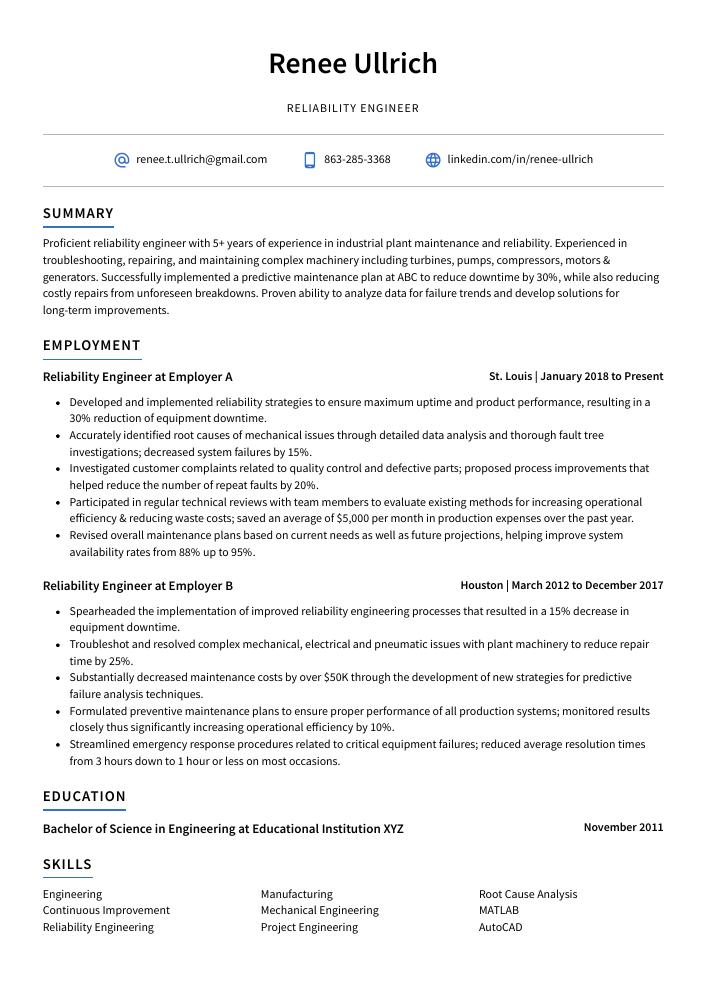Reliability Engineer Resume Guide
Reliability Engineers are responsible for ensuring that products and services meet customer requirements, minimize downtime, and maximize performance. They use data analysis to identify potential risks in a system or product’s design, develop preventative measures to reduce the likelihood of failure, and test systems to ensure they remain reliable over time.
You have the technical know-how to ensure that any system runs smoothly and efficiently. But potential employers don’t recognize your capabilities yet, so you must craft a resume that highlights your knowledge and experience in reliability engineering.
This guide will walk you through the entire process of creating a top-notch resume. We first show you a complete example and then break down what each resume section should look like.
Table of Contents
The guide is divided into sections for your convenience. You can read it from beginning to end or use the table of contents below to jump to a specific part.
Reliability Engineer Resume Sample
Renee Ullrich
Reliability Engineer
[email protected]
863-285-3368
linkedin.com/in/renee-ullrich
Summary
Proficient reliability engineer with 5+ years of experience in industrial plant maintenance and reliability. Experienced in troubleshooting, repairing, and maintaining complex machinery including turbines, pumps, compressors, motors & generators. Successfully implemented a predictive maintenance plan at ABC to reduce downtime by 30%, while also reducing costly repairs from unforeseen breakdowns. Proven ability to analyze data for failure trends and develop solutions for long-term improvements.
Experience
Reliability Engineer, Employer A
St. Louis, Jan 2018 – Present
- Developed and implemented reliability strategies to ensure maximum uptime and product performance, resulting in a 30% reduction of equipment downtime.
- Accurately identified root causes of mechanical issues through detailed data analysis and thorough fault tree investigations; decreased system failures by 15%.
- Investigated customer complaints related to quality control and defective parts; proposed process improvements that helped reduce the number of repeat faults by 20%.
- Participated in regular technical reviews with team members to evaluate existing methods for increasing operational efficiency & reducing waste costs; saved an average of $5,000 per month in production expenses over the past year.
- Revised overall maintenance plans based on current needs as well as future projections, helping improve system availability rates from 88% up to 95%.
Reliability Engineer, Employer B
Houston, Mar 2012 – Dec 2017
- Spearheaded the implementation of improved reliability engineering processes that resulted in a 15% decrease in equipment downtime.
- Troubleshot and resolved complex mechanical, electrical and pneumatic issues with plant machinery to reduce repair time by 25%.
- Substantially decreased maintenance costs by over $50K through the development of new strategies for predictive failure analysis techniques.
- Formulated preventive maintenance plans to ensure proper performance of all production systems; monitored results closely thus significantly increasing operational efficiency by 10%.
- Streamlined emergency response procedures related to critical equipment failures; reduced average resolution times from 3 hours down to 1 hour or less on most occasions.
Skills
- Engineering
- Manufacturing
- Root Cause Analysis
- Continuous Improvement
- Mechanical Engineering
- MATLAB
- Reliability Engineering
- Project Engineering
- AutoCAD
Education
Bachelor of Science in Engineering
Educational Institution XYZ
Nov 2011
Certifications
Certified Reliability Engineer
American Society for Quality (ASQ)
May 2017
1. Summary / Objective
A resume summary/objective is your chance to make a good first impression on the hiring manager. As a reliability engineer, you should use this section to highlight your technical skills and experience in keeping systems running smoothly. For example, you could mention how many years of experience you have working with complex engineering projects, any certifications or qualifications that demonstrate your expertise in the field, and how you successfully implemented preventive maintenance strategies at previous companies.
Below are some resume summary examples:
Well-rounded reliability engineer with 5+ years of experience troubleshooting and optimizing complex systems. Adept at designing, deploying, testing, and maintaining reliable processes that drive operational efficiency. Skilled in root cause analysis to identify system failures quickly while recommending long-term solutions for improved performance. Looking to join ABC Technologies as a reliability engineer to utilize my expertise in developing robust systems for their clients.
Committed reliability engineer with 8+ years of experience in developing and implementing reliability plans, conducting failure analysis, and improving system availability. At XYZ Inc., increased product life cycle by 65% through the introduction of new processes to improve maintainability. Looking to join ABC Tech as a reliability engineer where I can utilize my technical knowledge and expertise in increasing overall system performance.
Talented reliability engineer with 8 years of experience in developing and implementing reliability plans for large-scale production operations. Proven track record of reducing downtime, improving asset life expectancy, and increasing customer satisfaction. Experienced in identifying root causes of complex issues using Six Sigma methodology. At XYZ Company, saved $2M by optimizing the maintenance system and minimizing operational costs.
Detail-oriented reliability engineer with 5+ years of experience in research and development, troubleshooting, and product testing. Skilled at developing robust reliability test plans to reduce system downtime. At XYZ Corp., identified three significant design flaws that reduced failure rates by 25%. Seeking to join ABC as a reliability engineer where I can utilize my skillset to ensure quality performance across all products.
Enthusiastic reliability engineer with 5+ years of experience in the development and optimization of preventive maintenance plans. At XYZ, successfully reduced machine downtime by 35% through root cause analysis and improved reliability metrics using advanced predictive analytics. Possess a strong technical background, excellent problem-solving skills, and expertise in developing efficient strategies for maintenance programs.
Passionate reliability engineer with 9+ years of experience in developing and maintaining reliable systems using a variety of engineering principles. Experienced in creating robust testing plans to ensure reliability across products, services, and processes. Eager to join ABC Tech where I can apply my knowledge and skills to further improve the reliability standards for their clients’ needs.
Driven reliability engineer with 7+ years of experience in the field. Proven track record of reducing downtime and improving product quality by developing and implementing successful reliability plans, strategies, and solutions. Well-versed in root cause analysis techniques to identify potential problems before they occur. At XYZ Inc., improved customer satisfaction ratings from 72% to 87%.
Seasoned reliability engineer with 8+ years of experience in developing and leading reliability testing protocols. Expertise in identifying and resolving faults to ensure dependable performance, while reducing downtime costs by 53%. Proven track record of introducing new methods that reduce defects by 32%. Seeking to leverage my abilities at ABC Tech for high-quality product delivery.
2. Experience / Employment
The employment (or experience) section of your resume should be written in reverse chronological order, meaning that the most recent job is listed first.
When writing this section, stick to bullet points and provide detail about what you did and the results achieved. For example, instead of saying “Improved reliability,” you could say something like “Implemented a comprehensive system monitoring program which resulted in an 80% reduction in downtime.”.
This will help demonstrate how effective your work was at improving reliability for past employers.
To write effective bullet points, begin with a strong verb or adverb. Industry specific verbs to use are:
- Monitored
- Evaluated
- Diagnosed
- Resolved
- Implemented
- Investigated
- Optimized
- Automated
- Configured
- Troubleshot
- Documented
- Assessed
- Analyzed
- Upgraded
Other general verbs you can use are:
- Achieved
- Advised
- Compiled
- Coordinated
- Demonstrated
- Developed
- Expedited
- Facilitated
- Formulated
- Improved
- Introduced
- Mentored
- Participated
- Prepared
- Presented
- Reduced
- Reorganized
- Represented
- Revised
- Spearheaded
- Streamlined
- Structured
- Utilized
Below are some example bullet points:
- Successfully monitored and evaluated the reliability of more than 500 components, resulting in a reduction of downtime by 25% over six months.
- Structured preventive maintenance strategies to reduce repair costs by 15%, while continuously monitoring asset performance for potential failures.
- Evaluated current processes against industry standards and identified areas for improvement; implemented new procedures that increased overall system uptime by 10%.
- Resolved complex technical issues on an ongoing basis, including hardware malfunctions, software bugs, network disruptions and other operational errors within tight deadlines (averaging 4 hours).
- Developed detailed documentation outlining test cases for both existing systems as well as newly introduced technologies; successfully completed 3+ projects with zero defects reported post-release.
- Automated maintenance processes, resulting in a 20% reduction of downtime and an 18% increase in equipment reliability.
- Facilitated training sessions for technical staff on various aspects of reliability engineering; mentored 3 new engineers on maintaining high performance standards.
- Mentored junior engineers to develop their skillsets and improve their understanding of industrial maintenance practices and procedures.
- Upgraded existing infrastructure components with the latest technologies, increasing system availability by 45%.
- Effectively identified potential risks associated with operations and developed strategies to mitigate them; reduced risk-related losses by $25K annually.
- Introduced a comprehensive reliability engineering program to ensure high uptime and operational efficiency of over 250 pieces of equipment; increased machine availability by 25% in the first 6 months.
- Configured, tested and implemented predictive maintenance systems for plant machinery; reduced unplanned downtime incidents by 30%.
- Presented on various aspects of reliability engineering at industry conferences across the country, showcasing cost-saving measures that could be adapted into existing programs.
- Implemented a series of preventive maintenance strategies that saved an average of $3500 per month through optimized production processes & improved asset utilization rates by 15%.
- Diligently monitored key performance indicators related to plant operations such as mean time between failures (MTBF) and failure rate index (FRI); achieved MTBF targets within one month from implementation period start date.
- Assessed and evaluated the reliability of complex mechanical systems, identifying potential issues and implementing preventive measures that reduced failure rates by 15%.
- Improved system performance through root cause analysis to reduce downtime and repair costs; achieved an average savings of $7,000 per quarter across all projects.
- Meticulously maintained records for each component in accordance with industry standards to ensure compliance with safety regulations.
- Optimized operational efficiency by studying existing processes and recommending changes that resulted in a 20% increase in productivity levels over 6 months.
- Reorganized internal procedures related to maintenance activities, cutting down on redundant tasks while increasing accuracy of product data by 25%.
- Diagnosed and resolved over 30 complex technical issues per month, improving system reliability by 15% and reducing downtime incidents to zero.
- Analyzed root causes of equipment failures for more than 200 production machines on a weekly basis; identified potential problem areas that increased product quality by 40%.
- Expedited repairs and maintenance activities for all machinery, completing them within budgeted time frames in 75% of cases while running at full capacity with no safety violations or environmental concerns.
- Coordinated the efforts of 5 technicians to complete preventive maintenance tasks on schedule and improved machine uptime from 85% to 95%, resulting in an increase of $12,000 in annual revenue due to higher production output volumes.
- Efficiently managed inventory levels across all locations which saved the company $6,500 annually on spare parts replacement costs.
- Documented and analyzed system performance data, including uptime and downtime statistics; increased reliability by 25% in the first quarter.
- Achieved cost savings of $10,000 per year through preventive maintenance activities on critical systems.
- Independently reviewed engineering designs for new components to ensure their adherence to quality standards and specifications before implementation into production processes.
- Reduced repair costs by 40%, resulting from improved root cause analysis techniques applied during troubleshooting periods across multiple projects/locations simultaneously.
- Compiled detailed reports with technical solutions on system component failure trends which were used as a reference tool among teams and customers alike.
- Prepared detailed reliability reports on over 25 industrial systems and components, recommending changes to enhance overall system performance and reduce downtime by 30%.
- Demonstrated ability in identifying potential issues with existing equipment; successfully prevented one major mechanical failure through early detection of a fault.
- Advised management team on best practices in terms of preventive maintenance protocols, increasing the average lifespan of machines from 5 years to 7 years while reducing repair costs by $50K annually.
- Competently managed multiple projects involving the development & implementation of new technologies for improving reliability within budget parameters and ahead-of-schedule deadlines; improved parts delivery timescales by 20%.
- Utilized predictive analysis techniques such as root cause analysis (RCA) & failure mode effect analysis (FMEA) to identify key areas for improvement across all production sites, resulting in enhanced operational efficiency levels by 45%.
3. Skills
Skill requirements will differ from employer to employer – this can easily be determined via the job advert. Organization ABC may be looking for a reliability engineer with experience in predictive maintenance, while Organization XYZ may require someone who is proficient in root cause analysis.
It’s important to tailor the skills section of your resume accordingly because many employers use applicant tracking systems (ATS) these days. These are computer programs that scan resumes for certain keywords before passing them on to a human recruiter or hiring manager.
In addition to listing relevant qualifications and knowledge areas here, you should also discuss them further throughout other sections of your resume – such as the summary or work experience section.
Below is a list of common skills & terms:
- 5S
- AutoCAD
- C++
- CAD
- Commissioning
- Condition Monitoring
- Continuous Improvement
- Cross Functional Team Leadership
- Data Analysis
- Electrical Engineering
- Electronics
- Energy
- Engineering
- Engineering Management
- FMEA
- Factory
- Failure Analysis
- Finite Element Analysis
- Gas
- Inspection
- Instrumentation
- Kaizen
- LabVIEW
- Lean Manufacturing
- MATLAB
- Maintenance Management
- Maintenance and Repair
- Manufacturing
- Mechanical Engineering
- Mining
- Oil and Gas
- Petroleum
- Planned Preventative Maintenance
- Plant Maintenance
- Predictive Maintenance
- Preventive Maintenance
- Process Control
- Process Engineering
- Process Improvement
- Product Development
- Project Engineering
- Project Planning
- Pumps
- RCM
- Reliability
- Reliability Centered Maintenance
- Reliability Engineering
- Root Cause Analysis
- SAP
- SOLIDWORKS
- Six Sigma
- Team Leadership
- Teamwork
- Testing
- Time Management
- Troubleshooting
4. Education
Mentioning an education section on your resume will depend on how far into your career you are. If you just graduated and have no prior experience, include an education section below your resume objective. However, if you have plenty of work experience to showcase, omitting the education section is perfectly acceptable.
If an education section is included in your reliability engineer resume, try to list courses and subjects that are related to the job description for which you are applying.
Bachelor of Science in Engineering
Educational Institution XYZ
Nov 2011
5. Certifications
Certifications demonstrate to potential employers that you have the necessary skills and knowledge for a given job. They also show that you are committed to staying up-to-date on industry trends and best practices.
Including certifications in your resume is an excellent way of showing hiring managers that you are qualified for the position, as well as demonstrating your commitment to professional development.
Certified Reliability Engineer
American Society for Quality (ASQ)
May 2017
6. Contact Info
Your name should be the first thing a reader sees when viewing your resume, so ensure its positioning is prominent. Your phone number should be written in the most commonly used format in your country/city/state, and your email address should be professional.
You can also choose to include a link to your LinkedIn profile, personal website, or other online platforms relevant to your industry.
Finally, name your resume file appropriately to help hiring managers; for Renee Ullrich, this would be Renee-Ullrich-resume.pdf or Renee-Ullrich-resume.docx.
7. Cover Letter
Including a cover letter with your job application is a great way to make yourself stand out from the competition. It gives you an opportunity to explain why you are the perfect fit for the role and provide insight into who you are as a professional.
Cover letters usually consist of 2-4 paragraphs that outline why you’re qualified for the position, allowing hiring managers to get a better understanding of your experience and approach towards work. Even if it’s not required in some cases, writing one will always be beneficial when applying for jobs.
Below is an example cover letter:
Dear Telly,
I am writing to apply for the Reliability Engineer position at XYZ Corporation. I am a mechanical engineer with 5+ years of experience in reliability engineering, and I am confident that I can be an asset to your team.
In my current role as a reliability engineer at ABC Company, I have gained extensive experience managing all aspects of product development from conception to launch. My responsibilities include conducting failure analysis, developing test plans, and designing experiments to assess product reliability. In addition, I have also ledRoot Cause Corrective Action (RCCA) teams and implemented corrective actions to prevent recurrence of field failures.
Through my work experiences, I have developed strong analytical skills and a keen eye for detail. My ability to troubleshoot complex problems and find creative solutions will contribute to the success of your organization. In addition, I am also proficient in using statistical analysis tools such as Minitab and JMP which will come in handy when analyzing data collected from experiments or field tests.
I believe that my knowledge, skills, and abilities make me the perfect candidate for this position. Please find attached a copy of my resume for your review; if you have any questions or would like additional information about my qualifications please do not hesitate to contact me at [phone number] or [email address]. Thank you for your time and consideration; I look forward hearing from you soon!
Sincerely,
Renee
Reliability Engineer Resume Templates
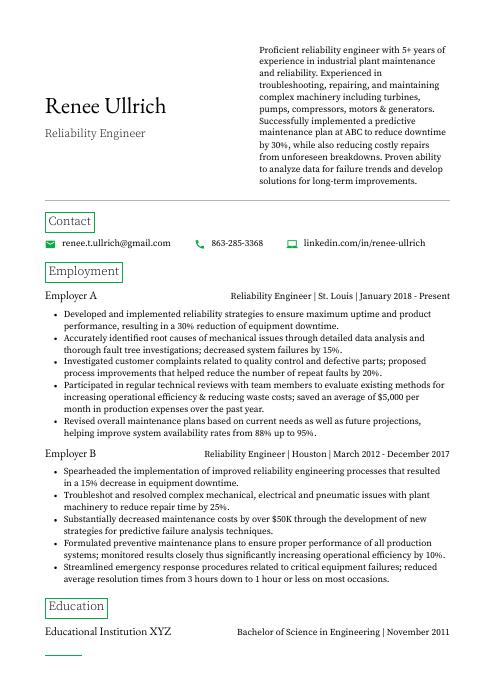 Quokka
Quokka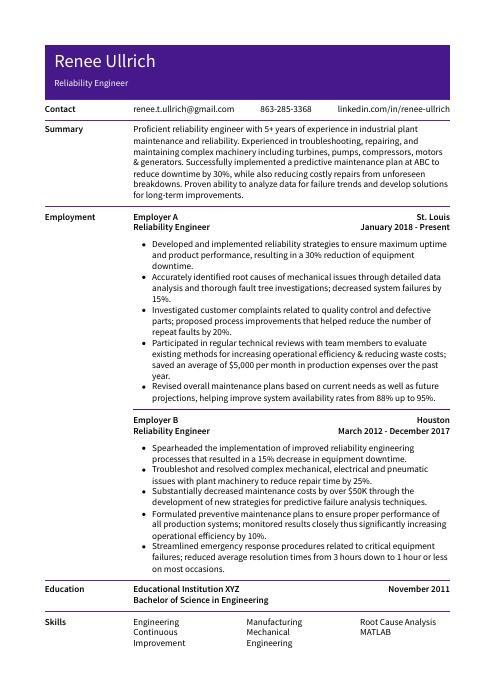 Pika
Pika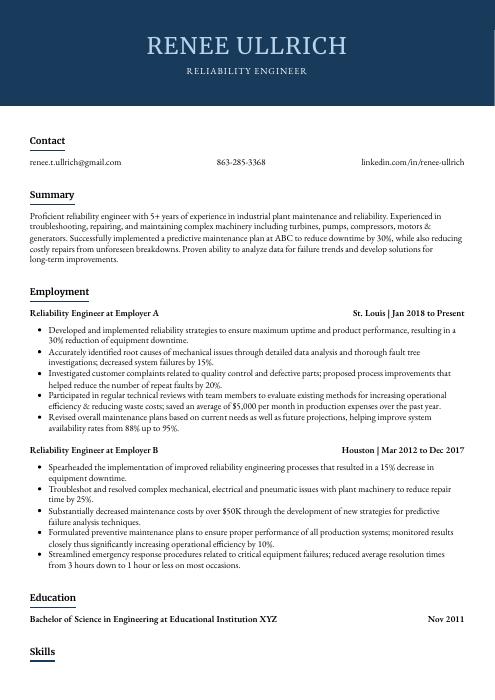 Bonobo
Bonobo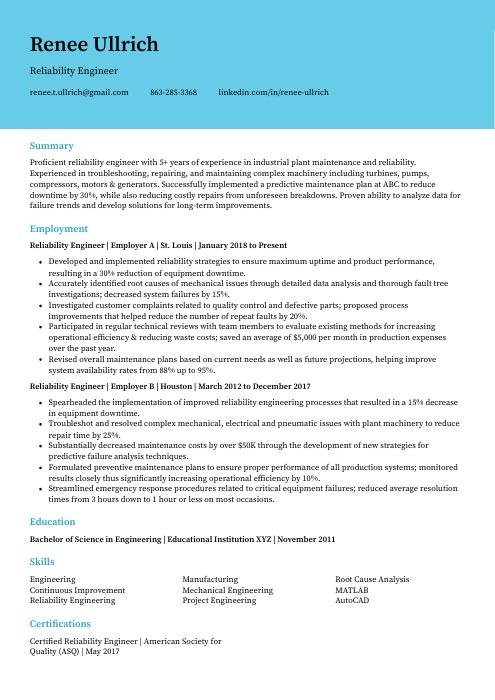 Dugong
Dugong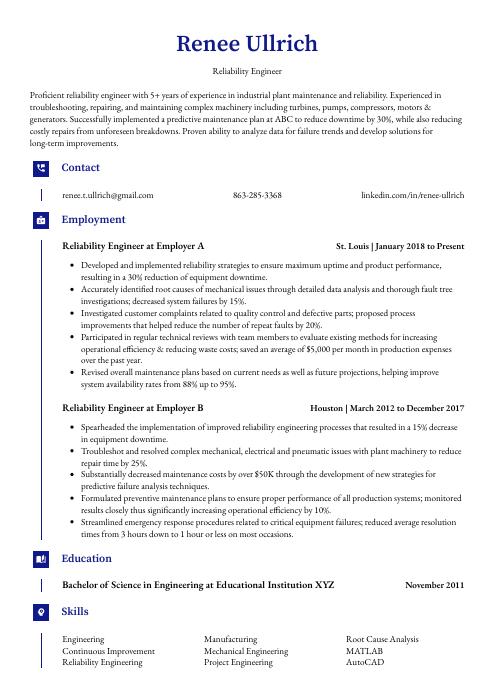 Gharial
Gharial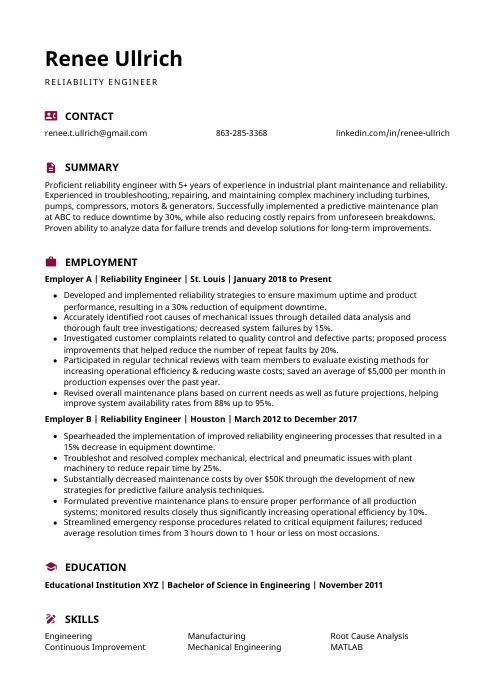 Hoopoe
Hoopoe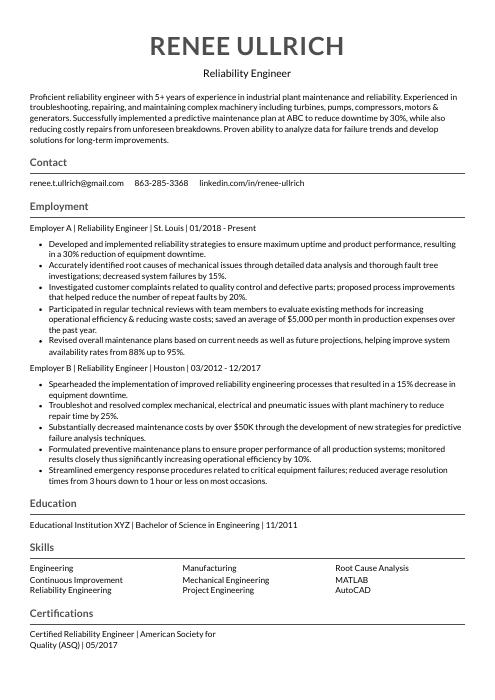 Indri
Indri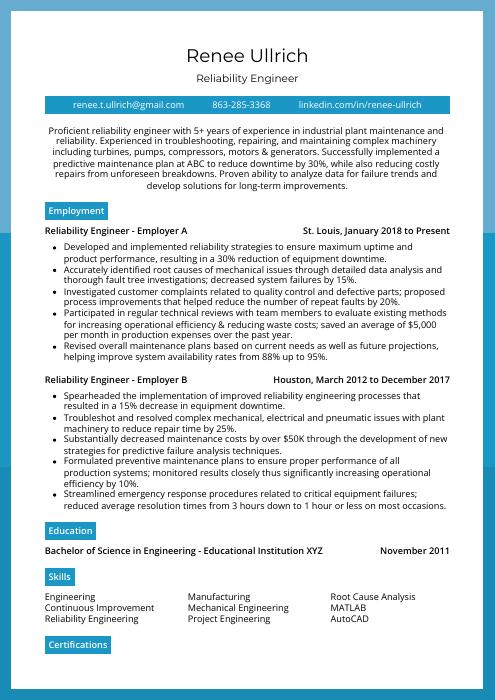 Rhea
Rhea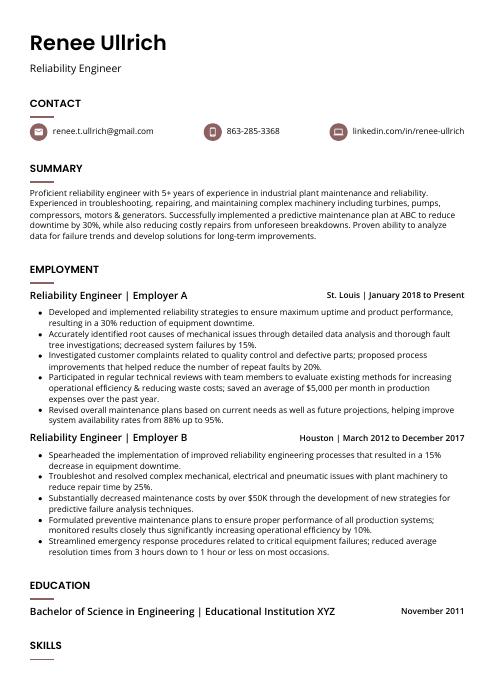 Fossa
Fossa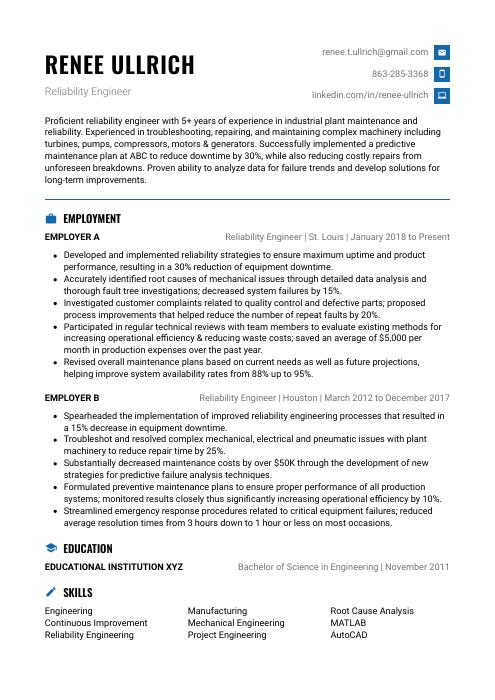 Echidna
Echidna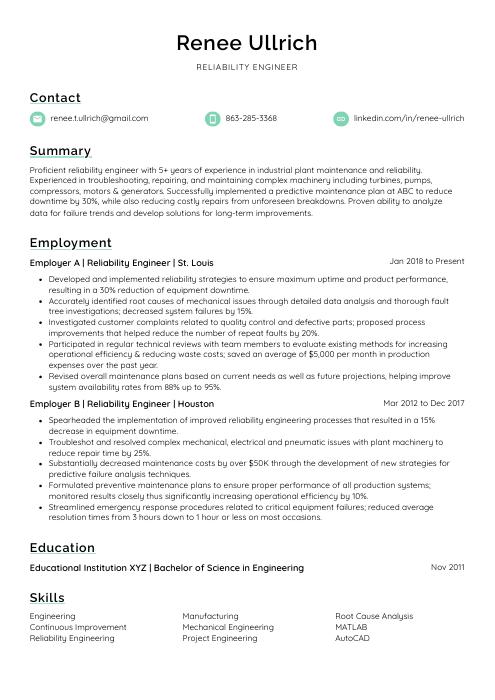 Lorikeet
Lorikeet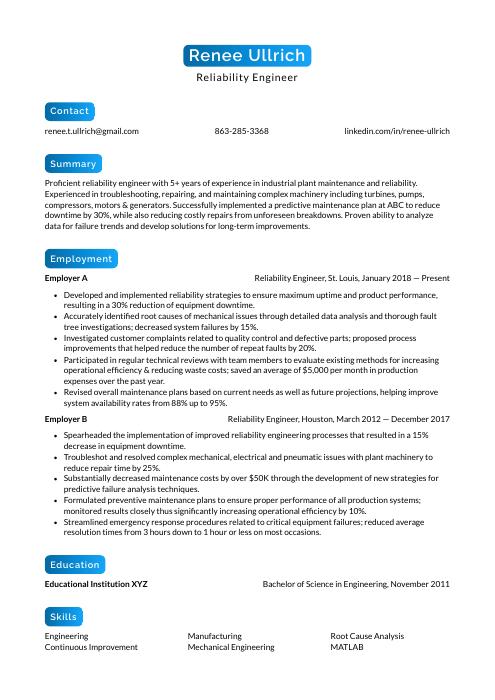 Kinkajou
Kinkajou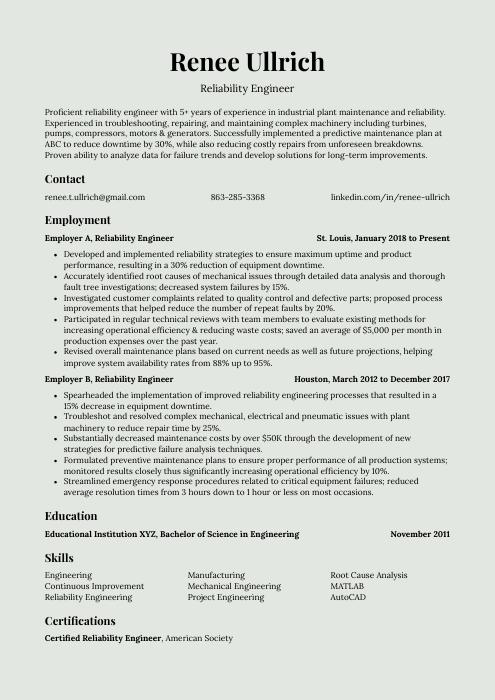 Saola
Saola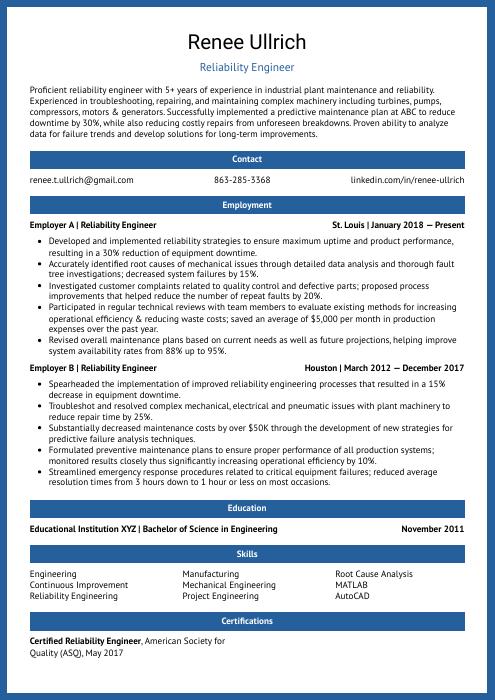 Ocelot
Ocelot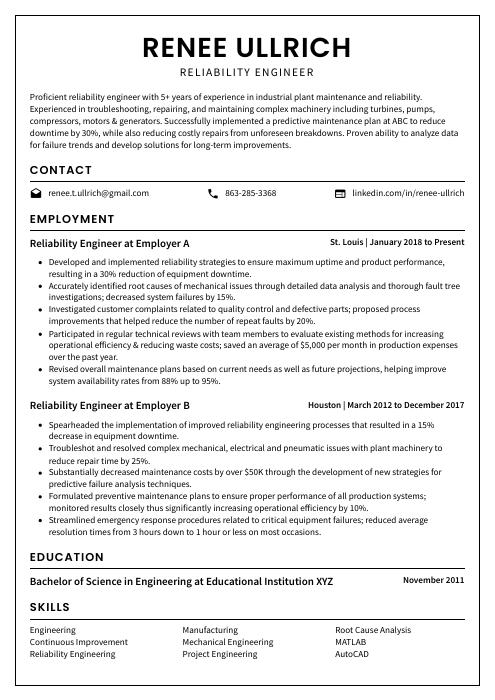 Cormorant
Cormorant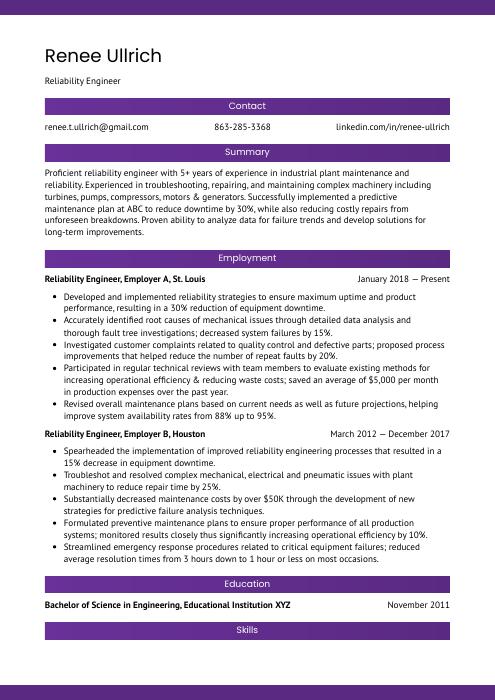 Jerboa
Jerboa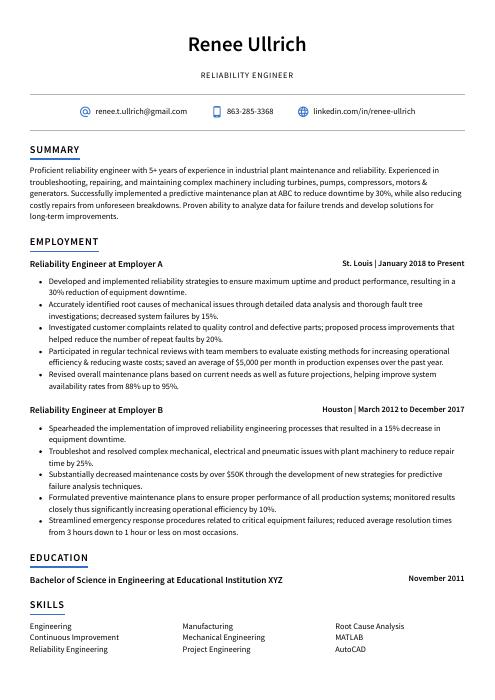 Axolotl
Axolotl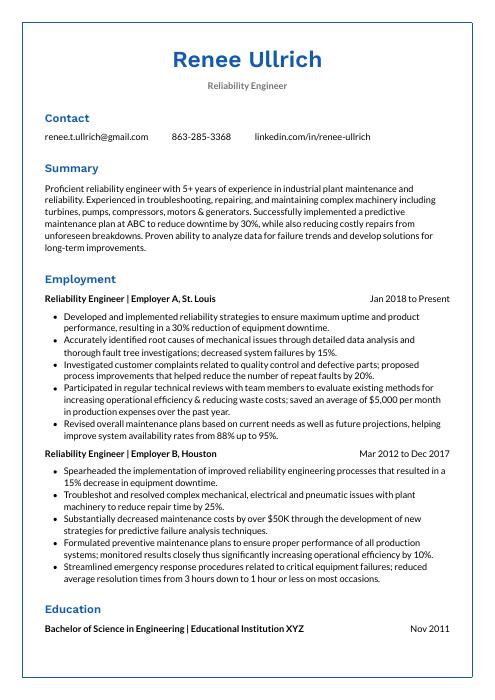 Markhor
Markhor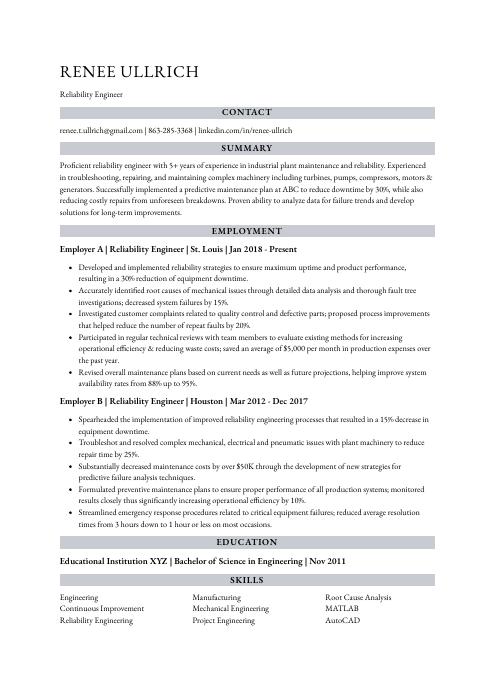 Numbat
Numbat Rezjumei
Rezjumei
